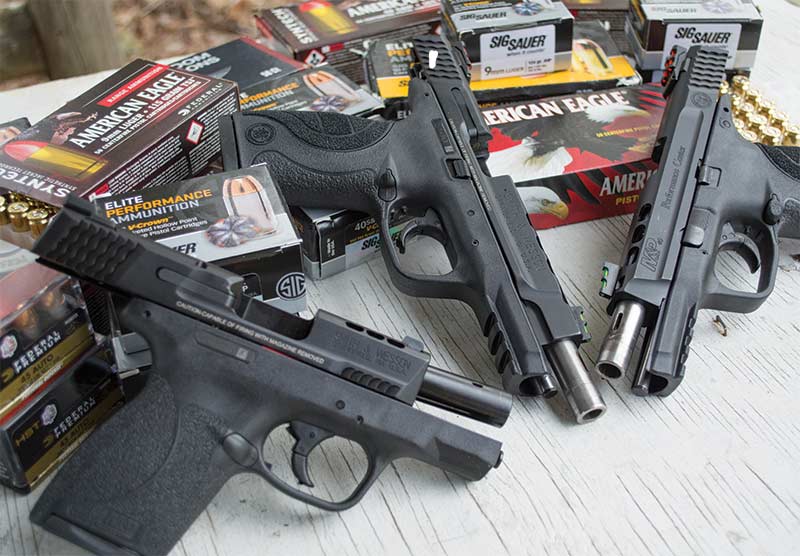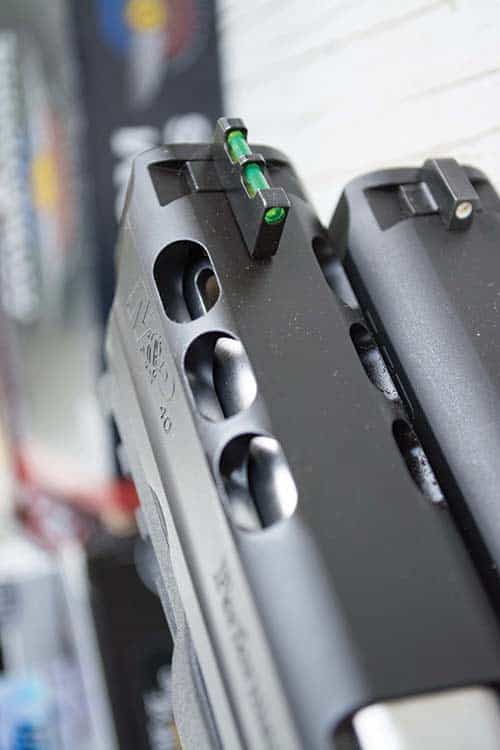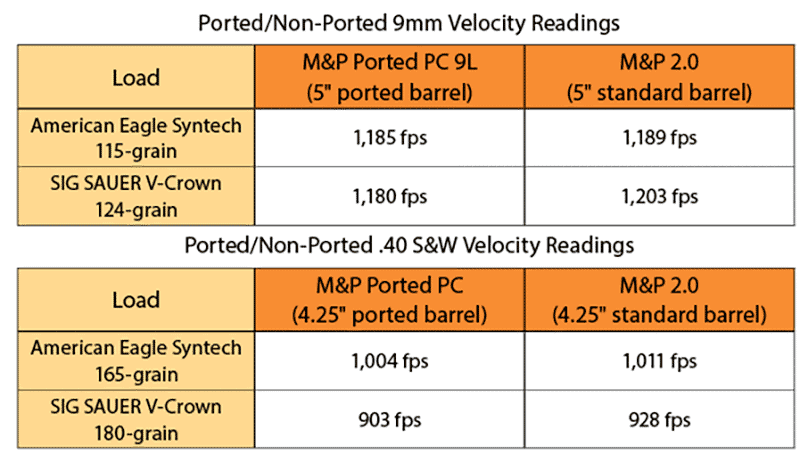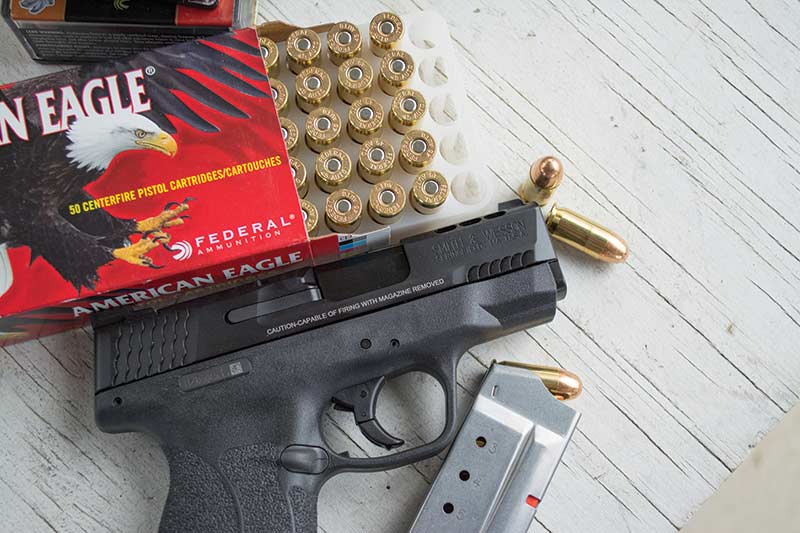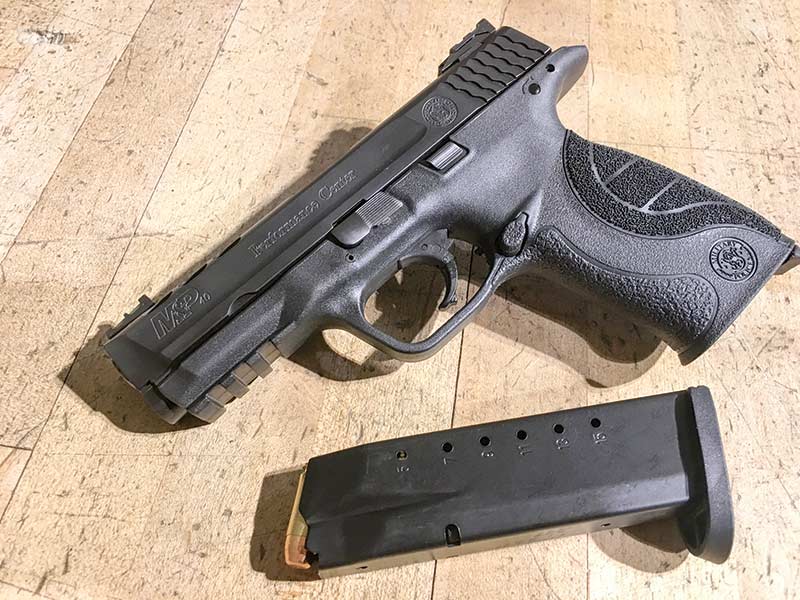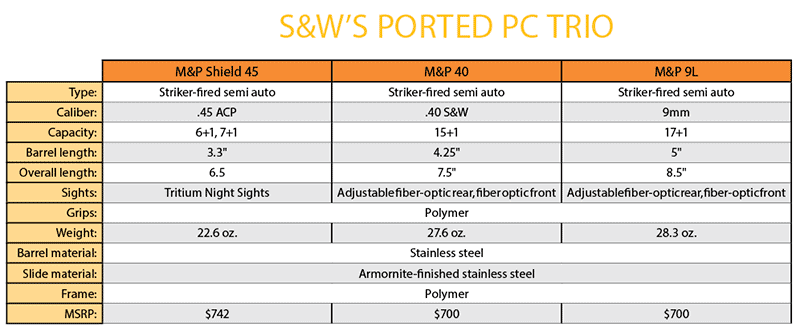Holy Handguns!
THE CHOICE: MUZZLE BLAST OR MUZZLE FLIP?
Here’s the Controlling Argument From the Port Side.
Some people swear once you go ported you never go back. Others claim Satan makes his guests use ported pistols while paying double for their ammo. I was an ambivalent “porter” until I spent some quality time with a few new Smith & Wesson Performance Center M&P pistols. Now? Read on and see.
The Issue Is Control
The technology is not new, the folks at Mag-na-port have been doing off-barrel drilling for 75 percent of forever. What is new is the apparent momentum behind porting, at least if you make the determination by the percentage of Performance Center guns leaving the factory full of holes.
So what’s the big deal? Porting is all about control. Those holes in the barrel direct hot gas straight up, creating tiny little rocket engines putting a damper on the muzzle’s desire to reach for the sky during recoil. The result is a gun that feels like it has less recoil because there’s less of a violent muzzle jump. As a result, you can (1) shoot big caliber handguns with less pain, (2) shoot moderate caliber guns more comfortably and with faster follow-up shots, and (3) ignite tiny pocket cannons with far less unpleasantness and a 79 percent reduction in temporary PTSD (okay, so maybe I made the last figure up, but I’m standing by it).
The whole temporary PTSD thing is how the assignment of testing the new Smith & Wesson Ported Performance Center M&P Shield 45 landed in my lap. Attending an S&W launch event with Editor Roy, I couldn’t help but notice his nervous twitch and the hint of a welling tear or two when the hosts encouraged us to try the new pocket cannon Shield 45. Pocket 45 guns are for big boys after all. Having remembered to wear my safety pin and pack my blankie, I volunteered to handle the testing of the new Ported PC M&P Shield 45 and two other Ported PC pistols while I was at it.
Shortly after returning home, I received a box of pure happiness and joy from the Performance Center: a ported Shield 45, a full-size .40 S&W with a 4.25″-ported barrel, and a 9mm long slide with a 5″-ported barrel.
The variety of these models illustrates the different potential applications for factory ported pistols. For example, the Shield, as a 22-ounce pocket pistol, is a handful for many shooters (like some unnamed magazine editors) to control when chambered in big calibers like .45 ACP. As for the .40 S&W model, it’s a great carry gun solution for someone who wants a caliber starting with a “four” but also wants the controllability of a 9mm.
As for the 9mm long-slide model, I think it will shine as a competition gun. The 9mm is clearly not known for punishing recoil or big muzzle flip, but when every bit of muzzle rise adds fractions of seconds to your stage time, the porting can help create an edge because it’s easier to keep the sights on target from shot to shot.
As PC models, you might expect other nifty add-ons besides porting, and you’d be correct. The ported pistols all feature an enhanced trigger. If you’ve found the original M&P triggers to be a bit on the mushy side, you’ll like what the PC team has done with all three of these pistols. They feature a low-resistance take-up stage, followed by a constant pressure movement to a far crispier break than on the original standard factory models. I measured the trigger weight at 5.5 pounds for all three guns. You’ll also notice a more audible and tactile trigger reset if you’re into micro-managing your trigger. The M&P Shield 45 offers a choice of Tritium night sights or HIVIZ fiber optic tubes. The long slide 9mm and .40 S&W models are geared for daytime shooting with HIVIZ fiber optic sights.
I’ve been shooting all three of these guns over numerous range visits, and while the feel is a subjective thing, I would qualify the porting effect as an almost-full caliber reduction. What I mean is the 9mm shoots like a .380 while the .40 S&W shoots more like a comparable 9mm. As for the pocket blaster Shield 45, even Editor Roy can handle it with hardly any post-range counseling.
Of the three, the gun that piqued my interest was the Shield. Full-size standard guns in either 9mm or .40 S&W are fairly easy to handle due to their size, large surface area for hand contact, and of course, weight. For those, porting isn’t as much a necessity as a luxury. However, while one can shoot a tiny 45, it’s not necessarily fun. Given a choice between a 200-round practice session with a 42-ounce, all-steel 1911 and a 22-ounce pint-sized polymer pistol, I’d choose the 1911 94 times out of 100.
However, this little gun changes the math entirely. It’s actually fun to shoot, even one-handed. In fact, to test it out, I did most of the shooting using full-weight 230-grain defensive ammo including SIG SAUER V-Crown and Federal HST. On the practice ammo side, I used 230-grain American Eagle FMJ and 230-grain American Eagle Syntech. All of these loads ran flawlessly, and I didn’t experience any of the typical function sensitivity you often see shooting big calibers from lightweight guns.
After video taping a number of one-handed shots in slow motion with my iPhone, I noticed I was getting about half the muzzle flip with the ported pistols as opposed to standard pistols of the same type. I believe the reason for the dramatic increase in shooting joy results from the dampening of the wrist snap effect. Big caliber but lightweight guns tend to not only recoil straight back, but also snap your wrist skyward in an unnatural direction. If you think about those two actions, the straight back movement simply pushes directly through your arm into your body weight. Muzzle flip has no such backstop, and your wrist takes all the abuse. My theory is anything you can do to negate the aggressive muzzle flip makes the whole recoil experience much more tolerable.
The bottom line? These ported guns are fun to shoot. Fun to shoot means fun to practice. Fun to practice means proficiency. In fact, I think any of the three would make an excellent carry solution. But wait you say, ported guns have big drawbacks and can get you killed on the street! Won’t the fiery muzzle blast destroy your night vision? Won’t the porting slow down the velocity of your expensive self-defense ammo to that of a soggy spitball? Let’s consider those myths.
The Velocity Factor
Having cleaned out S&W’s entire sample gun inventory, I also had matching “standard” guns for two of the ported models. I was able to shoot the new Smith & Wesson M&P 2.0 5″ barrel 9mm side by side with the ported 9mm long slide and an M&P 2.0 4.25″ barrel .40 S&W next to the ported M&P with a 4.25″ barrel. Because science is fun, I set up a Shooting Chrony Beta Master Chronograph on my own range and recorded velocities of identical ammo from ported and non-ported guns. Here’s the Tale of the Tape:
So, if I elect to go with 9mm, porting costs me between 4 and 23 fps. If I choose .40 S&W, porting costs me between 6 and 25 fps. No biggie, especially considering the benefits. Just for kicks, even though I didn’t have a standard barrel Shield .45 ACP, I checked the velocity of the ported model with a few popular loads. American Eagle 230-grain Syntech clocked in at 753.8 fps while Federal HST 230-grain and SIG SAUER V-Crown 230-grain left the bore at 800.9 and 810.2 fps respectively. Again, nothing to lose sleep over.
Flashes, Fireballs, Fiction
I think I’ve heard the myth about muzzle blast and night vision more often than MSNBC hosts cry on the air (never underestimate the power of hearsay). In my view, it’s a load of hooey. Here’s why. Any handgun, especially when torching off a higher-power self-defense load, is going to generate a sizeable fireball. And guess what? Unless you’re really intent on seeing it, you won’t.
Having shot many thousands of rounds from pistols, rifles, and shotguns in the dark, seeing my target for the second shot has not once been an issue in the History of Ever. Perhaps if you hibernated in the depths of an abandoned gold mine for a few hours and allowed your eyes to adjust to pure inky blackness, you’d see post-shot spots in your vision. But I have to ask, in conditions like that, how are you seeing and identifying your target? If you want the benefits of porting, don’t let this old wives’ tale stop you.
Don’t believe me? Try it sometime. If there’s enough ambient light for you to see and identify a target, whether environmental or from a handheld or weapon-mounted light, you’re not going to go blind by pressing the trigger, ported barrel or not.
Of course, porting technology is no substitute for skill. Relying on muzzle technology to manage recoil isn’t intended to be a crutch for supporting lazy technique. Rather, I like to think porting helps you get even better results when using sound shooting form. After tinkering with these pistols, I’ve come to the conclusion you can teach an old dog new math. I want one.

